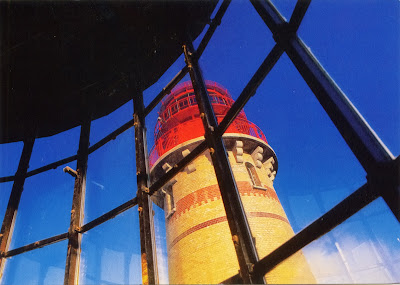Located off the Pomeranian coast in the Baltic Sea, Rügen is Germany's largest island by area. The "gateway" to Rügen island is the city of Stralsund, where it's linked to the mainland by road and railway. The coast is characterized by numerous sandy beaches, lagoons (bodden) and open bays (Wieke), as well as projecting peninsulas and headlands. Rügen is very popular as a tourist destination because of its resort architecture, the diverse landscape and its long, sandy beaches. The main body of the island, Muttland, is surrounded by several peninsulas, among which is Jasmund, where is located Jasmund National Park, famous for its vast stands of beeches and chalk cliffs like King's Chair (in the first postcard, first top left, besides the name of the island), the main landmark of Rügen island. This park was designated a UNESCO World Heritage Site in 2007, as part of the site Primeval Beech Forests of the Carpathians and the Ancient Beech Forests of Germany.
In the first postcard are, from left to the right, from the top left corner:
1. Sellin Pier - located in the seaside resort of Sellin. The first 508m long pier with a restaurant, built in 1906, was destroyed by fire in 1920. In 1925 a new pier was built, but was also destroyed, this time by ice, in the winter of 1941/1942. A new pier, including a restaurant, was opened in 1998. At 394m it is the longest pier on the island.
2. Cape Arkona - a 45m high cape which forms the tip of the Wittow peninsula, just a few kilometres north of the Jasmund National Park. On the cape there are two lighthouses, a navigation tower (built in 1927 - in the foreground), two military bunker complexes, the Slavic temple fortress of Jaromarsburg and several tourist buildings (restaurants, pubs and souvenir shops).
4. Granitz Hunting Lodge - located in the vicinity of the seaside resort of Binz. Was built on the highest hill in East Rügen, the 107m above sea level high Tempelberg, in the years 1838 to 1846 by order of Prince Wilhelm Malte I of Putbus, based on a design by Berlin architect, Johann Gottfried Steinmeyer in the style of the North Italian Renaissance castellos.
In the second postcard is the highest lighthouse (35m) in Cape Arkona, seen from the smaller lighthouse (19.3m), built of brick in 1826-1827, based on plans by Karl Friedrich Schinkel. Called also the Schinkelturm (Schinkel Tower) was taken out of service in 1905. It is the second oldest lighthouse on the German Baltic Sea coast after the Travemünde Lighthouse. The largest tower was built in 1901-1902 right next to the old tower. It is made of brick and stands on an octagonal granite base. For 90 years its light source was two arc lamps, but they were replaced in 1995 by a Metal-halide lamp.
Read more »






















